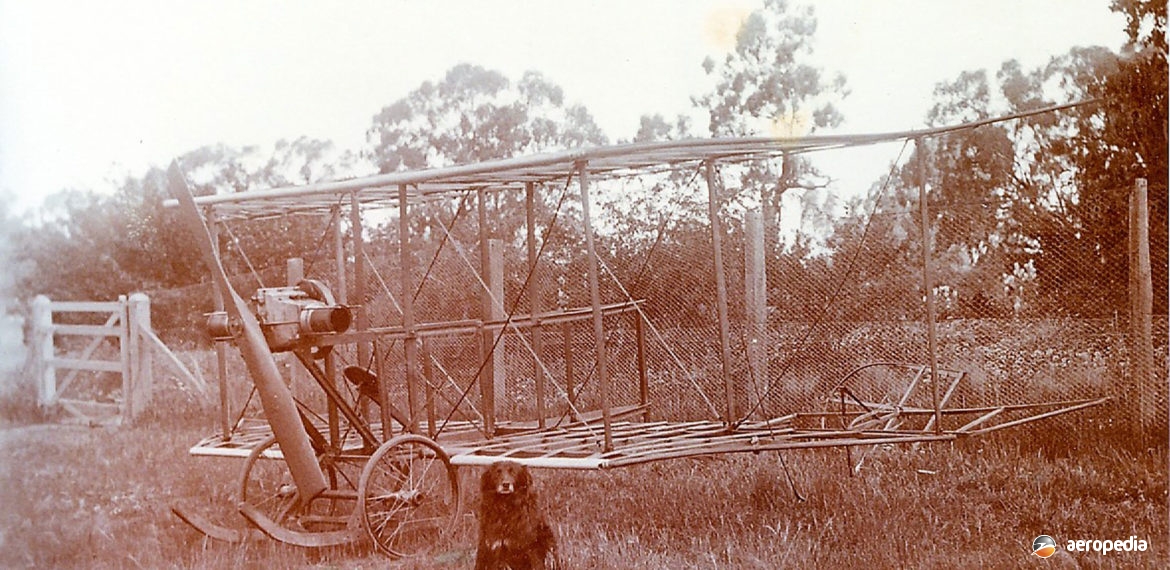Photograph:
The completed Sloane Biplane in 1913 (Yarrawonga / Mulwala Pioneer Museum, NSW)
Country of origin:
Australia
Description:
Single-seat biplane
Power Plant:
One 25 kw (34 hp) to 28 kw (38 hp) two-cylinder horizontally-opposed air-cooled engine
Specifications:
- (Approximate)
- Wingspan: 7.3 m (24 ft)
- Length: 3.8 m (12 ft 6 in)
- Height: 2.43 m (8 ft)
- Empty weight: 138 kg (304 lb)
- Loaded weight: 231 kg (510 lb)
History:
William Douglas Sloane (known as Douglas) was born on 4 June 1890 at Mulwala Station north of Yarrawonga, VIC. He attended school at Geelong and gained an interest in aviation, first building rubber-powered models, some with wingspans up to 0.60 m (2 ft), most having “a tail like a wedge-tailed eagle”. He developed an aptitude for mechanical things and, in about 1911, commenced the design and construction of a tail-less biplane in the woolshed on the property. He also designed and built a two-cylinder engine for the aircraft, the latter being completed in workshops near St Kilda in Melbourne, VIC. The engine was a 216 cubic-inch two-cylinder horizontally-opposed air-cooled unit with overhead valve gear, a bore of 12.7 cm (5 inch) and a stroke of 13.97 cm (5.5 inch), and has been estimated to have been able to provide between 18 kw (24 hp) and 28 kw (38 hp). The propeller was a two-blade unit 1.98 m (6 ft 6 in) in diameter hand-carved by the designer/ builder.
This aircraft was designed and built in the 1912-1913 period as a biplane flying-wing with canard mounted elevators. It seems in about April 1914 Mr Sloane attempted to fly the aircraft at what was known as Dicks Plain on the Mulwala Station. However, it refused to fly, the designer being of the view the weight of the engine was too great for the power generated. Construction was of long-grain softwood (Canadian Spruce) with fabric covering.
It was found when the engine was at full power the aircraft would not become airborne. It was then decided to tow the aircraft at speed. Alexander Sloane (brother) and Andrew O’Bryan (a friend) restrained the aircraft by a rope and, with the aircraft attached to the family’s 1911 Hudson car called the Scarlett Runner, with its engine running, was towed at a speed up to 64 km/h (40 mph) across the paddock. The car and the aircraft hit a mound of earth and the machine became airborne but “the propeller still lacked power, and Douglas was unable to maintain any height, so the biplane quickly returned to earth”.
Mr Sloane then set about designing and building a more powerful engine. However, World War I intervened and it would seem no more attempts to fly were made, the aircraft being placed into storage on the property. Mr Sloane joined the AIF on 2 October 1916 and was posted to No 2 Squadron, AFC. As a 2nd Air Mechanic in England he served with No 69 Squadron AFC, this unit being transferred to France in August 1917. On 21 August 1917 Mr Sloane was delegated to travel on the transfer in the rear seat of an RAF RE.8. En-route a forced landing was made at Biggin Hill, Westerham. Repairs were effected, but on take-off the aircraft “spun off a turn and crashed, killing both occupants”. Mr Sloane, who was 27 years of age at the time of death, was interred on 25 August 1917 after a military funeral at the Australian Military Burial Ground at the Brookwood Cemetery at Brookwood in Surrey.
The aircraft remained in storage until about 1970 when it was recovered and partly restored. In 1996 it was placed on display at the Yarrawonga / Mulwala Pioneer Museum in New South Wales. The aircraft is basically complete but some parts, such as controls, fittings and the like, are not fitted, and the original engine is missing the head.

